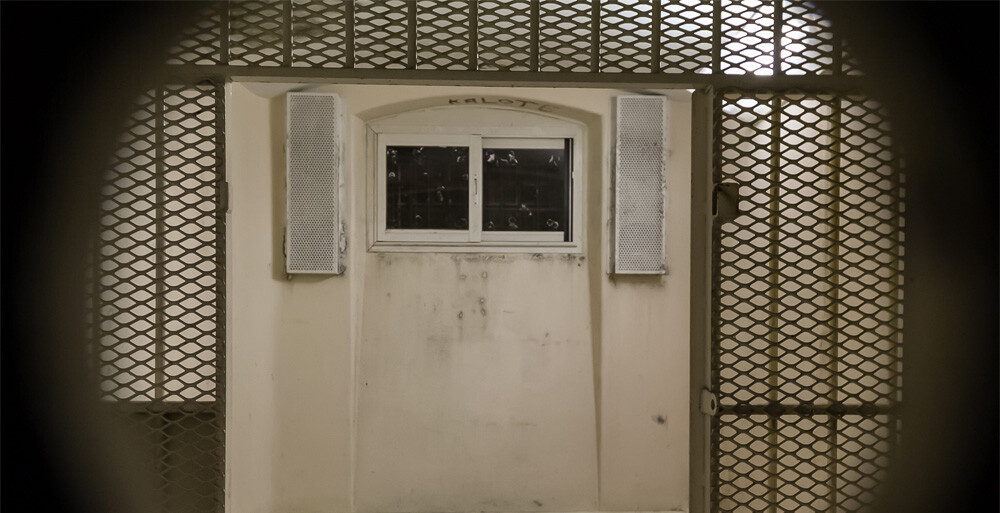7 Horror Stories That Came From Real-Life, Not Movies

Every time we start to think we’ve made sense of the universe, the universe decides to throw us a curveball. A seemingly normal day always has the potential to become a horror story straight out of Hollywood without warning. But at least with movies, you can turn the TV off …
The Byford Dolphin Incident
Humans do not respond very well to pressure. We don't mean the stress of day-to-day life kind of pressure, to which our species is kinda hit or miss. No, we're talking atmospheric pressure. There's a reason barometers and altimeters are set to clear days at sea level because that's when and where humans have evolved to work at peak efficiency. Any changes to those readings could cause strange things to happen to the human body. Some people can get a sinus headache if a storm rolls in too quickly. People get tired and cranky on airplanes because the cabin pressure is about the same as being trapped inside a football.
Don't Miss
More extreme pressure changes can make the human body go absolutely haywire. What makes climbing Mt. Everest so dangerous isn't just the cold but the loss of motor function because the thinner air causes your brain to swell like a marshmallow in the microwave. It's even worse for scuba divers, where the intense water pressure can wreak havoc on your body if you're not extremely careful. Going too deep with the wrong air mixture in your tanks, rising to the surface too quickly, or boarding an airplane too soon after diving could cause extremely painful or deadly side effects.

Six men experienced the absolute worst-case scenario of pressure change on November 5, 1983, onboard the Byford Dolphin, a semi-submersible drilling rig that was, at the time, located in the North Sea off the Norwegian coast.
The rig utilized a technique known as saturation diving, which minimized the length of time divers would normally spend decompressing after a dive and re-acclimating their bodies to the pressure at the surface. Even a one-hour dive at these kinds of depths would require around 50 hours of decompression, so with saturation diving, these divers would live in pressurized chambers with special air mixtures long enough to allow their bodies to reach an equilibrium with that harsh environment. You know that underwater rig system from The Abyss? Same setup, just with none of the aliens, nuclear warheads, or rat torture.

20th Century Studios
Uh, gonna have to get back to you on that.
Divers Bjorn Bergersen and Truls Hellevik were coming back from their shift in a diving bell to join other divers Edwin Coward and Roy Lucas in the decompression chamber, which had already been hoisted to the surface. Two dive tenders, William Crammond and Martin Saunders, were assisting in this operation from the outside of the chamber. Before Hellevik could finish closing the hatch to the chamber, Crammond inexplicably opened the clamp to the diving bell, sending it flying off. All four men inside went from nine atmospheres of pressure down to one in an instant. Explosive decompression.
Coward, Lucas, and Bergersen died where they stood, and it was ruled that the rapid change in pressure had instantaneously sucked all of the gas molecules out of their blood. Their blood boiled, people! Outside the chamber, Crammond also died instantly, and Saunders was severely injured.
But Truls Hellevik … he was standing just inside the hatch all of the pressure was escaping from, in the process of closing it when it happened, and at that moment there was only a 24-inch-long crescent-shaped gap. We really don't want to be too graphic here, so we'll just say you'll probably never look at a Play-Doh Fun Factory the same way again.

In the end, the accident on the Byford Dolphin was blamed on human error, with a dishonorable mention to the obsolete engineering and lack of safeguards on the decompression system. The victim's families were ultimately compensated for the incident, and it only took them … 26 years to get a ruling on that.
Ryan Blair: The Crocodile Hunted
Crocodiles are perhaps the most vicious creatures on Earth, and even by crocodile standards, the saltwater crocodile is particularly terrifying. It can swim three times faster than any human ever could, and unless you're an Olympic-level sprinter, don't expect to be able to outrun them on land, either. They can grow to up to 21 feet long, live up to 70 years, their jaws can snap bones like balsa wood, and their diet consists solely of any creature unlucky enough to enter their field of vision. They are also very patient hunters. Basically, your best hope of escaping them is to never go anywhere near them in the first place.
New Zealander Ryan Blair learned that lesson the hard way back in 2013 during his vacation in Western Australia. After having been dropped off by boat to explore Governor Island on a kayak, Blair had no idea his tour was about to become a two-week nightmare because a 20-foot saltwater croc started stalking him.

Each time Ryan Blair tried to escape the island, the croc would move closer and closer to his kayak, forcing him to turn back to shore and the relative safety of his campsite. Rationing his food and water, Blair tried for two weeks in vain to flag down passing boats with a signal fire, but no one stopped. That was until boatman Don MacLeod, who had seen the monster surface next to his boat, spotted the signal fire, put two and two together, and came to Blair's rescue.
Once aboard the boat, MacLeod gave Blair a beer, which he admitted probably "was probably the wrong thing to do." Alcohol definitely doesn't pair well with dehydration, but on the other hand, once you've been rescued from the crankiest sumbitch that 200 million years of evolution could possibly offer … yeah, it's Miller time!
Strangely, one day after getting Ryan Blair to safety, Don MacLeod saved another man whose boat was attacked by a crocodile. Blair took a vacation from his vacation to rest up before returning home, and we prefer to believe he and that other croc victim teamed up, and now they spend their days advocating in support of crocodile poaching.
Daniel O’Brien’s (Not That One) Baffling Suicide
First off: Not former Cracked staffer Daniel O'Brien. He's doing well, and, as always, we wish him the best.
Meanwhile, Daniel John O'Brien's last day on Earth reads like the most insane Grand Theft Auto side quest ever, so please take time to process each step of this story and spare a thought for the poor police detectives who had to piece this together through eyewitness testimony.

On January 14, 1990, O'Brien and his traveling companion, David Meyer, were at the end of a two-week vacation on the island of Trinidad. They were due to fly back to the U.S. in the morning. Around 9:40 pm, O'Brien went for a swim in the hotel pool while Meyer got some sleep. About a half-hour later, Meyer was woken up by O'Brien trying to choke him. The two men struggled, Meyer got knocked out with a reading lamp, and O'Brien ran out of the room. Oh, and we should probably mention O'Brien was naked during all of this.
In the hallway, O'Brien grabbed a 20-pound fire extinguisher off the wall and attempted to spray it down his own throat. After this "plan" failed to work, O'Brien ran outside the hotel, saw the airport, and decided he must get in there. So, he scaled two 10-foot fences with barbed wire on top. Again, he was buck-ass nude.

Airport security was alerted to his presence, and four guards drove over to confront O'Brien. They managed to subdue the intruder and detain him in their jeep. Three of the officers transported O'Brien to the security office while one guard stayed behind to inspect the fence, we're guessing after a round of rock-paper-scissors and a "Have fun with the naked guy!"
On the ride back to the office, O'Brien managed to free himself, take down two of the guards and overpower the driver. Before anyone back at base could get on their radios and say, "I'm sorry, could you repeat that? Over!" O'Brien was speeding away in the jeep and made a beeline towards British Airways flight 256, which was standing at the end of the runway awaiting clearance for take-off.
Ground crews could only watch in horror as O'Brien crashed the jeep into the plane and sheared off the top of the vehicle … only to see him emerge from the wreckage moments later, running around like a man possessed and smearing the blood gushing from his wounds all over his body. And before anyone's brains could fully absorb that imagery, O'Brien ran straight towards the running jet turbine and dove in. At which point, everyone with a window seat on that side of the plane instantly regretted not choosing the aisle.

There wasn't a lot of information given as to what set off this rampage. It was reported that in the days leading up to the event, Daniel O'Brien "had been suffering from 'disorientation' after being unable to find an unnamed medication for an unnamed health problem." Which is exactly the kind of vague explanation you'd expect from any poor soul who had reached their psychological limit having to investigate this crazy mess. We're assuming that information was given by someone five whiskeys deep, staring off into the void while chain-smoking and letting the ashes fall on a pile of witness statements.
Canadian Prison Inmate Dies From Having Religion Shoved Down His Throat
On June 9, 1987, an inmate at the Metropolitan Toronto East Detention Centre named Franco Brun was transported by ambulance to a local hospital after he was found unresponsive in his cell. He was pronounced dead, but one of the doctors had already determined the cause of death: Brun had choked to death on a pocket-sized copy of The Bible lodged in his throat.

congerdesign/Pixabay
That doctor initially suggested to police that this was an act of murder and must be investigated immediately, claiming there was just no way a man could possibly shove a Bible that far down his own throat. Although, not to be pedantic, it was technically only the New Testament. The Old Testament is way harder to swallow, or at least that was the assessment of Paul the Apostle.
There was just one small problem with the murder theory: Brun had been alone in a windowless cell all day, and the guards had been checking in on him every 20 minutes or so. Those guards later stated that they did notice that Brun looked like he was trying to fit his fists in his mouth, but they never suspected he was actually trying to swallow a book.

"Cool, cool, everything normal."
It's unclear why Brun was allowed to have the book with him in the cell at all, seeing as the reason he had been placed in solitary was that he was caught in his previous cell holding that Bible open with one hand while the other was … um … feeling the Holy Spirit, so to speak. Look, we compiled about three pages worth of religious-themed euphemisms for masturbation here, and that one seemed like the least hell-worthy.
Well, maybe this was one of those cases where a prisoner had been behind bars long enough for the guards to know when they're just acting out, but nope! Franco Brun was only 22, and he was on day six of a 15-day sentence for petty crimes. The jail psychologist had already examined Brun and concluded that he was acutely psychotic. They had prescribed medication to calm him down, but Brun refused to take them.

Brun had told his family during a phone call from jail that someone had told him that the devil was in him, and that's why he kept committing sins. At the formal inquest into the incident, the coroner stated that "the swallowing of the Bible to him was some form of symbolism or allegory as though he was trying to purge himself of the devil by consuming religion."
The jury at the inquest ultimately ruled that due to Franco Brun's delusional state, his death was an accident rather than a suicide. That jury also had some strong recommendations for the jail staff on how to better handle inmates who are in extreme mental distress. And just to be on the safe side, we would like to suggest that all prison Bibles be stamped with the words "Read it, don't eat it."
British TV Producers Take "The Show Must Go On" To A Ridiculous Extreme
One of the staples of British television from the 1950s to the 1970s were live teleplays, giving their home audiences a taste of attending a stage production from the comfort of their living rooms. One such program was Armchair Theatre, which aired on ITV every Sunday night with a new, original story each week using a rotating cast of actors.

ITV
Now, anything can happen on live television, and when something goes wrong, the best they can do is just roll with it. However, on November 28, 1958, the broadcast of a play titled Underground nearly went completely off the rails when actor Gareth Jones missed his cue and failed to enter the next scene, forcing the production to resort to what many actors (and audiences) dread more than death: improv.
Fortunately, Jones didn't have a major role in the play, but his character was supposed to relay some information that was crucial to the plot. During the commercial breaks, the producers scrambled to assign some of Jones' lines to other actors wherever they could, resulting in such completely normal-sounding lines as "I'm sure if so-and-so were here he would say …"
All the while, those producers refused to inform the actors what had actually happened to Gareth Jones. A couple of actors actually caught a glimpse of Jones falling on his way to enter the scene but thought that maybe he had taken a bad spill. Turns out, Jones had suffered a fatal heart attack on his way to the stage, and the producers didn't want to upset the cast with the bad news, so they went with the "We'll talk about this later" approach.

ITV
ow, it's bad enough that these actors had to maintain their professionalism and get through this play while worrying about what happened to their fellow castmate. It's even worse that immediately afterward, they had to find out that he had died. Add to that the cruel irony that Jones' character also died of a heart attack late in the play, and the other characters had to deal with that. Life imitating art for Jones, reverse method acting for the rest of the cast.
Lumberjack Nearly Cuts Off His Own Head, Drives Himself To Get Help
There is a fine line between bad luck and rotten luck, but how one perseveres through it is where absolute legends are made. Allow us to introduce you to a man who reached Greek god-level legend status. He was a lumberjack named Forthman Rexdale Murff, a man so utterly badass we're gonna resist the urge to make fun of his name.

On May 26, 1984, Murff was alone in the woods outside Tupelo, Mississippi, clearing out some trees when suddenly, he was sent a very clear message that the universe wanted him dead. He had just cut down one tree that began to fall towards him, so he hopped out of the way. Suddenly, an unexpected downdraft pulled a limb from another tree that fell 80-90 feet, striking Murff in the shoulder, landing him in a ditch about ten feet away. As this happened, the initial tree pulled down another tree, which landed directly on his foot.
Needless to say, all this caused Murff to become a little woozy. He passed out briefly and woke up to find his chainsaw was still running … halfway through his neck. About the only thing that still attached his head to his body was his spine, carotid arteries, and a small section of skin. His windpipe, esophagus, jugular vein, muscles … all cut clean through, or as clean as a chainsaw could possibly cut, that is.

After removing the saw, Murff freed his shattered foot from under the fallen tree and hopped about 150 yards back to his truck while holding his own nearly severed head onto his shoulders. He drove a half-mile to a neighbor's farmhouse, who then drove Murff 27 miles to the nearest hospital. Bear in mind, all of this took place over the span of one hour.
Doctors called Murff's survival a miracle. Murff himself believed he survived because the Lord needed him to take care of his ailing wife. In case you were wondering how high the bar was set for romantic gestures, there you go. If the person you're with would let being almost completely decapitated stop them from taking care of you, is it really love?
Forthman Murff made nearly a full recovery from the accident and lived another 19 years before passing away in 2003 at the age of 92. He didn't even let the accident stop him from picking up another chainsaw, although we're pretty sure he had a much deeper focus on safety from then on. We're guessing he also maintained a steady income from hearing other people whine about their problems and saying, "20 bucks says I got you beat!"
Millionaire’s Survival Bunker Becomes A Death Trap
Daniel Beckwitt is proof that while money cannot buy you happiness, it can afford you an extensive collection of red flags. His wealthy parents were extremely overprotective, taking the concept of helicopter parenting to Black Hawk levels. His parents homeschooled him, rarely let him play with any other children, and almost never let him leave the house without them. Daniel's only real connection to the outside world was his time spent on 4chan. Yeah, he was already on the fast track to being more than a little weird.

Shortly after Daniel went away for college in 2010, his mother fell ill and died suddenly. She left Daniel with a $2.6 million trust in her will. Unfortunately, her death also left Daniel with a severe and irrational fear of death. While that money was meant to provide him with financial security, he would spend a lot of it on desperate measures to make himself feel physically safe.
He went and had every mole on his body removed as a precaution against skin cancer. He was so terrified of car accidents he wore an armored vest whenever he drove his late mother's minivan, which he had reinforced with Kevlar plates. Living in his parents' house in Bethesda, Maryland, and being so close to Washington, D.C., he was increasingly paranoid of a possible nuclear attack from North Korea, so he went down into the basement one day and started digging a bomb shelter.
By 2015, Daniel Beckwitt had started broadcasting from his still-in-progress underground bunker on the video chat site Blab, having created a new online persona as a cryptocurrency millionaire and investment guru by the name of 3AlarmLampscooter. No one could tell who he really was on these live feeds because he kept his face hidden under a fireproof suit and modulated his voice. You know, exactly the kind of person you'd want giving you financial advice.

It was on one of these video chats, he was introduced to Askia Khafra, a 21-year-old "entrepreneur" whose dreams of making money were only outmatched by his naiveté. Online, Khafra gave Beckwitt a soft sell for his idea for a new crowdfunding app he was trying to get off the ground that would allow people to invest small sums of money in new startups. Think Kickstarter meets Shark Tank, or GoFundMe meets RobinHood, or whatever combination of tech buzzwords you think would get rich weirdos to make it rain.
Khafra and his business partner had it all planned out, and they were applying for a $100,000 grant created by tech billionaire Peter Thiel. Beckwitt agreed to meet up with the partners to discuss investing seed money for the project and eventually decided to give them $5,000 cash to help them with their grant presentation, and they could pay him back with the money they'd get out of it. If they didn't land the grant, they could pay it all back some other way.

No! Not that way!
Not only did Khafra and his partner fail to win the grant, they epically failed. First problem: The meeting was in San Francisco, and they booked their flight for Los Angeles. Second problem: Neither of them were old enough to rent a car for the 400-mile drive, but they could rent a U-Haul, and their GPS told them they'd be arriving just in the nick of time. Third problem: they put in the wrong address and ended up on the opposite side of town. They blew it.
Feeling horrible for having failed to secure the money to pay off his debt to Beckwitt, Askia Khafra offered to work it off by helping dig out the rest of the underground bunker. Beckwitt agreed, but there were strict conditions. Adamant that absolutely no one knows the location of the bunker, Beckwitt would pick Khafra up and make him wear a blindfold the whole way there, telling him they were heading somewhere in outstate Virginia. Beckwitt would drive in loops to make the drive seem longer and would not allow Khafra to remove the blindfold until he had been guided to the tunnel entrance through a maze of clutter in the basement.
Khafra would live in the bunker for days on end while he worked, sleeping on a mattress in the corner, pooping in a bucket, and only communicating with Beckwitt through Google chats. If he needed anything like food, he would message the man upstairs, and it would get dropped down to him. Any time he wished to return home, he'd have to put the blindfold back on, and the whole charade would play out all over again.

Around 2:30 am on September 10, 2017, Khafra sent Beckwitt a series of urgent messages telling him they had lost power in the tunnel and the airflow had stopped. Beckwitt was asleep and didn't see the messages for another six hours. He went down to rearrange the power strips and plug them into a different circuit. They had these kinds of power outages all the time, and let's be honest, it's not like this project was being built up to code.
With the power and airflow restored, they were able to get back to work. Later in the day, they discovered a new problem: The carbon monoxide detector was going off. A fire had sparked somewhere in the basement. Beckwitt yelled down to Khafra to get out of the tunnels, then ran outside to safety. Khafra managed to reach the basement, but with the thick smoke and having been blindfolded every time he had ever been in there, he couldn't find his way out. The coroner later speculated that Khafra likely died of smoke inhalation before the fire got to him.

During the investigation into the fire, Beckwitt was found to have made several false statements in hopes that the investigators would wrap things up before they found out about the bunker. Once the truth was found out, Daniel Beckwitt was charged with Involuntary manslaughter and second-degree "depraved-heart" murder, which alleged that he knew there was a high chance someone could get killed but didn't give enough of a crap to do anything about it.
Beckwitt was convicted on both counts and sentenced to nine years in prison, although the "depraved-heart" conviction was overturned earlier this year. The manslaughter charge still stands, and now the courts are trying to determine if or how his sentence should be adjusted. Considering what his victim had to suffer through, there is an undeniable irony that Beckwitt has had to navigate through a maze of legal obstacles only to fail to free himself.
When Dan Fritschie isn’t trapped in a vicious cycle of staying up late researching the kinds of stories that keep him from falling asleep, he can occasionally be seen performing stand-up somewhere. You can find him on Twitter.
Top image: Montgomery County Circuit Court
